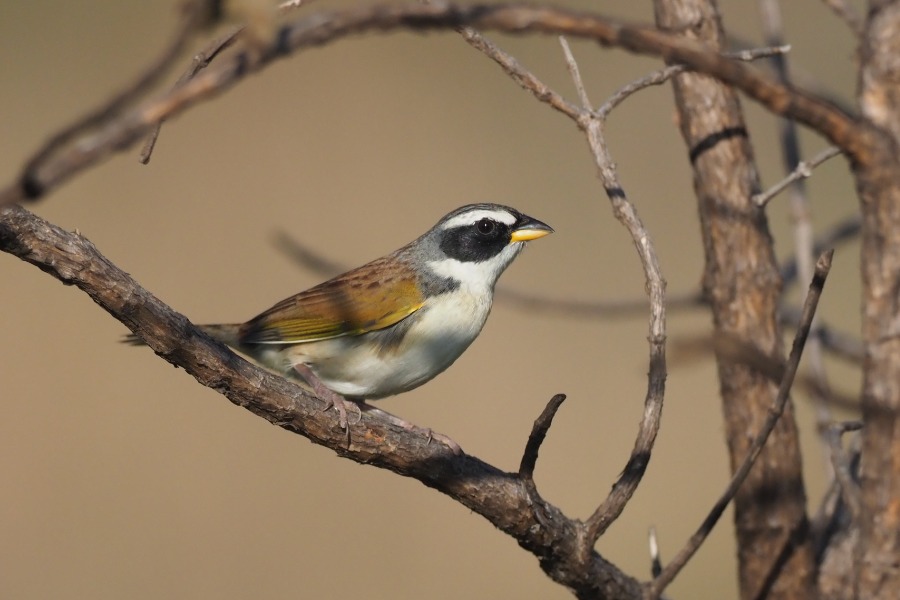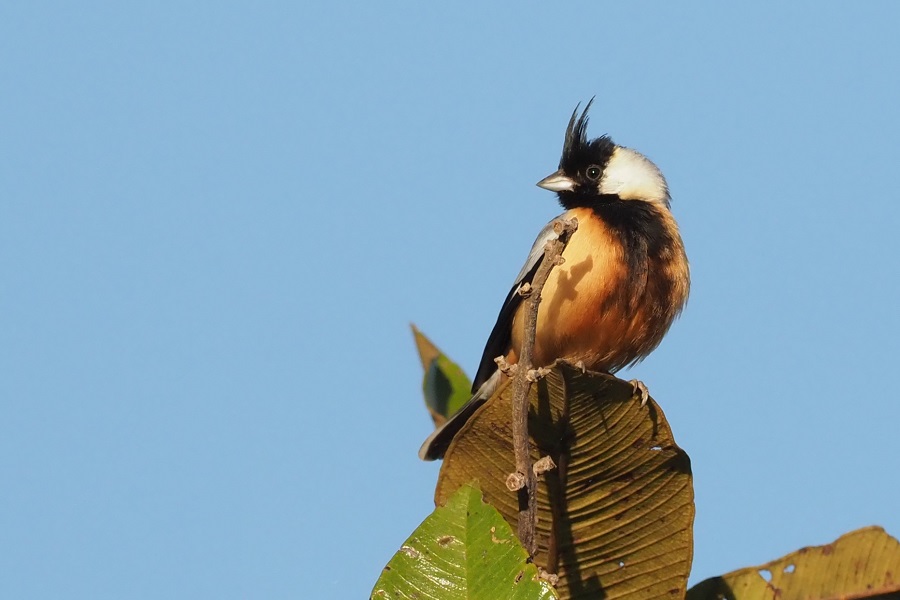Brazil: Interior
Explore the magnificent Canastra National Park in search of Brazilian Merganser, Cock-tailed Tyrant, and Blue Finch before heading east across Minas Gerais towards Hyacinth Visorbearer and Blue-eyed Ground Dove! Other specialties include Diamantina Sabrewing, Dwarf Tinamou, Red-legged Seriema, Ocellated Crake, Collared Crescentchest, Helmeted Manakin, Coal-crested Finch, and the fabulous Red-legged Seriema. Mammals will hopefully include both Giant Anteater and Maned Wolf. Several of our Ornis leaders consider this route one of the best bird tours in the world!
Next Dates
8 September - 23 September 2026 (16 days)
Leaders:
Eduardo Patrial
Group Size Limit:
6
Single Room Supplement: $
500 USD
Deposit: $
750 USD
Price: $
6400 USD
Add a Title
Leaders:
Eduardo Patrial
Group Size Limit:
Add a Title
Single Room Supplement: $
TBD
Deposit: $
TBD
Price: $
TBD
Add a Title
Accommodation:
All comfortable hotels and guesthouses.
Walking difficulty:
Mostly easy roadside birding, though a few moderate birding trails around Serra do Cipó / Serra do Caraça, plus one steep multi-hour hike for Diamantina Sabrewing and Cipó Canastero (optional).
Tour cost includes:
All accommodation, main meals, drinking water, internal flights (as stated in itinerary), overland transport, tips to local drivers and guides, travel permits, entrance fees, and guide fees.
Tour cost excludes:
Flights before and after the tour start/end, visa, travel insurance, tips to tour leaders, laundry, drinks, and other items of a personal nature.


IMPORTANT: In mid-2025, the Blue-eyed Ground Dove reserve was closed to the public. If it does not reopen, we will need to reroute the final three days of the tour to target a different set of species. These potential changes will be advised closer to the date.
Day 1: Tour starts in the morning at Confins International Airport (CNF), the main airport of Minas Gerais, serving the state capital of Belo Horizonte. The drive to our first destination - the beautiful Serra do Cipó - should take only an hour and a half! This famous geological formation is part of the larger and more complex Espinhaço Mountain Range, which extends for ~1000 kilometres, mostly through Minas Gerais (with a small part creeping into Bahia). After lunch and check-in, we will enjoy the afternoon on the hills at around 1200 m elevation, covering the beautiful campo rupestre (rocky scrub). Some of the main Espinhaço endemics include Hyacinth Visorbearer, Cipo Canastero, Grey-backed Tachuri and Serra Finch. Night in Serra do Cipó.
Day 2: Full day of birding at Cipó. We will visit the very scenic campo rupestre from the hills of the lovely Lapinha da Serra. There, we expect to maximise our chances with some of the uncommon endemics, such as Cinereous Warbling Finch, Cipó Canastero, and “Cipo” Long-tailed Cinclodes. Taking a rising trail through this fascinating habitat, we will also look for the recently split and now localised endemic, the Diamantina Sabrewing. There is also a strange population of Long-tailed Reed Finch up here, utilising the unusual habitat and with a few distinct plumage features.
Birding in the Cerrado around Lapinha or Serra do Cipó can provide a bunch of extra birds, including Small-billed Tinamou, Hyacinth Visorbearer, White-vented Violetear, the impressive Horned Sungem, Red-legged Seriema, White-eared Puffbird, Toco Toucan, Checkered Woodpecker, Firewood Gatherer, endemic Band-tailed Hornero, Rufous-fronted Thornbird, Rufous-winged Antshrike, Streamer-tailed Tyrant, Southern Scrub and Suiriri Flycatchers, Plain-crested and Lesser Elaenias, Curl-crested Jay, Black-throated Saltator, the stunning Blue Finch, Cinnamon, Shrike-like, and White-rumped and Burnished-buff Tanagers. If there’s still time, we can finish the day in dry woodland near our accommodation searching for endemic Caatinga Puffbird and Silvery-cheeked Antshrike, plus Black-capped Antwren and Pale-bellied Tyrant-Manakin. Night in Serra do Cipó.
Day 3: Day transfer to Caraça Sanctuary. In the early morning, we will visit the eastern side of Cipó’s plateau, areas of grasslands, and Atlantic Forest remnants. Our main targets are the endemic Rock and Marsh Tapaculos. Others found in the area include White-barred Piculet, Lesser Grass Finch, Long-tailed Reed Finch, Yellow-rumped Marshbird, Hellmayr’s Pipit, Mottle-cheeked Tyrannulet, Ochre-faced Tody-Flycatcher and endemic Gilt-edged Tanager. Driving south to a magnificent corner of the Espinhaço Mountains, we arrive at the Caraça Sanctuary, which will give us a taste of the Atlantic Forest. The private reserve combines scenic transitions of humid valleys to campo rupestre, all surrounded by prominent hills: a very contrasting landscape! After checking into the impressive monastery building, we should bird a mix of Atlantic Forest and campo rupestre, mainly after the endemic Serra Antwren. This evening, the century-old tradition of Maned Wolf feeding should give us the best chances of experiencing a very close encounter with this astounding species at the monastery’s front door! Night at Caraça Sanctuary.
Day 4: Our full day in Caraça will be supreme for Atlantic Forest endemics. Different trails in the reserve will offer a large new array of birds. Highlights include Dusky-legged Guan, White-collared and Biscutate Swifts, Scale-throated Hermit, Brazilian Ruby, Hyacinth Visorbearer, Slaty-breasted Wood Rail, Tawny-browed and Rusty-barred Owls, Rufous-capped Motmot, Surucua Trogon, Green-billed Toucan, endemic Crescent-chested Puffbird and Yellow-eared Woodpecker, Robust Woodpecker, Plain, Maroon-bellied and Golden-capped Parakeets, Scaly-headed Parrot, Lesser, Scaled, Planalto and White-throated Woodcreepers, Buff-fronted, White-eyed and Buff-browed Foliage-gleaners, endemic Orange-eyed Thornbird, Rufous-capped, Grey-bellied and Pallid Spinetails, Sharp-tailed Streamcreeper, Rufous-breasted Leaftosser, Giant, Large-tailed and Tufted Antshrikes, endemic Ferruginous, Ochre-rumped, and White-bibbed Antbirds, Star-throated and Serra Antwrens, Black-capped Antwren, Rufous Gnateater, endemic Rock and White-breasted Tapaculos, Spotted Bamboowren, Blue and Pin-tailed Manakins, Serra do Mar Tyrant-Manakin, the uncommon Swallow-tailed Cotinga, endemic Cinnamon-vented Piha and Grey-hooded Attila, endemic Hangnest Tody-Tyrant, Grey-capped Tyrannulet, Yellow-lored Tody-Flycatcher and Velvety Black Tyrant, Blue-naped Chlorophonia, Chestnut-vented Euphonia, colourful Brassy-breasted and Gilt-edged Tanagers, and hundreds more. Interesting endemic primates are found in Caraça, and we have a good chance of seeing Black-tufted-ear Marmoset and Black-fronted Titi Monkey. Maned Wolf can always improve the day in the evenings, as well as some night excursions for nightjars and owls. Night at Caraça Sanctuary.
Day 5: Day transfer to São Roque de Minas. After an early morning excursion on the grounds of Caraça, we will have a quite long day transfer to São Roque de Minas (7 hrs drive), southwest in the state, the main gate of Serra da Canastra National Park. We should arrive by late afternoon, but if time allows, we can start looking for a few birds in Cerrado habitat next to our hotel. Possibilities include Collared Crescentchest, Crested Black Tyrant, endemic Stripe-breasted Starthroat, and the amazing Helmeted Manakin. Night in São Roque de Minas.
Day 6-7-8: Three full days to explore the unique tableland of Serra da Canastra. Created in 1972, the National Park protects the upper reaches of two significant watersheds in Brazil: The Paraná and the São Francisco. The chest-shaped tableland (where the name Canastra comes from), with altitudes approaching 1500 m, also protects grasslands - one of the most threatened habitats in the Brazilian Cerrado. Emblematic mammals like the notorious Giant Anteater, the threatened Maned Wolf, and Pampas Deer, are part of the local fauna. The clear waters of Canastra also contain the largest population of the rare and Critically Endangered Brazilian Merganser. Here, we will count on spare time to look for this main rarity. Other highlights include Greater Rhea, Red-winged Tinamou, Spotted Nothura, rare Lesser Nothura, King Vulture, Black-chested Buzzard Eagle, rare Chaco Eagle, Great Horned Owl, rare Sickle-winged Nightjar, Band-winged and Spot-tailed Nightjars, White-collared, Biscutate and Great Dusky Swifts, Planalto Hermit, endemic Stripe-breasted Starthroat, White and Little Woodpeckers, Red-legged Seriema, Aplomado Falcon, endemic Golden-capped Parakeet, uncommon Yellow-faced Parrot, Campo Miner, rare Planalto Foliage-gleaner, Firewood-gatherer, Sharp-tailed Streamcreeper, Large-billed Antwren, Collared Crescentchest, endemic Brasilia Tapaculo, Helmeted and Pin-tailed Manakins, Southern Antpipit, Sharp-tailed Grass Tyrant, Grey-backed Tachuri, uncommon Rufous Casiornis, the fascinating Cock-tailed Tyrant, Curl-crested Jay, Tawny-headed Swallow, Ochre-breasted Pipit, endemic White-striped Warbler, Blue Finch, Black-masked Finch, Shrike-like and White-rumped Tanagers, Stripe-tailed Yellow Finch, Plumbeous and Dubois’s Seedeaters, and more. While in Canastra, we should also take the opportunity to sample the local cheese and coffee, some of the best in the country! Nights in Serra da Canastra.
Day 9: Morning drive to the town of Pompéu for a one-night stay. With the help of local guides, we should visit different sites in Cerrado to try for the shy Ocellated and Rufous-faced Crakes. The rich Cerrado in the area should offer several additions to our list and chances to catch up with missing species. Highlights include Lesser Nothura (difficult), Plain-breasted Ground Dove, Blue-and-yellow and Red-bellied Macaws, Turquoise-fronted Amazon, Rusty-backed Antwren, Henna-capped Foliage-gleaner, Campo Miner, Greater Thornbird, Chotoy Spinetail, Chapada Flycatcher, Black-faced Tanager, Coal-crested Finch, and Black-masked Finch. Night in Pompéu.
Day 10: Most of the morning will be spent in Pompéu, checking for crakes and more Cerrado specialties. In the late morning, we will start the long drive to Montes Claros, the main city in northern Minas, which is to be our base for two nights. On arrival, we can begin exploring the typical deciduous forest of the São Francisco region, which contains hundreds of birds and some uncommon localised endemics. Night in Montes Claros.
Day 11: Full day exploring the rich mata seca (deciduous forest) of Lapa Grande State Park in Montes Claros. The park is right next to the town, and its nice suite of birds will entertain us for the day. Here, we expect to record highlights such as endemic Yellow-legged Tinamou, the localised and recently described Outcrop Sabrewing (split from Grey-breasted Sabrewing), Sombre Hummingbird, Rusty-breasted Nunlet, endemic Spotted Piculet and Ochre-backed Woodpecker, Caatinga Parakeet, another chance for Henna-capped Foliage-gleaner, endemic Caatinga Cacholote, Ochre-cheeked Spinetail, Stripe-backed Antbird, Black-bellied Antwren, endemics Silvery-cheeked Antshrike and Planalto Slaty Antshrike; the uncommon and localized Minas Gerais Tyrannulet and Sao Francisco Black Tyrant, the rare Reiser’s Tyrannulet, endemic Ash-throated Casiornis, White-naped Jay, Sao Francisco Sparrow, Campo Troupial, Pale Baywing, Red-cowled Cardinal, and uncommon Scarlet-throated Tanager. Night in Montes Claros.
Day 12: Morning travel northwest to the Cavernas do Peruaçu National Park. The mata seca and physiognomies from the Caatinga biome are the habitats we will be covering here. The National Park protects the typical mata seca, along with one of the most important archaeological sites in South America: caves featuring rock art dating back thousands of years (which we will make time to visit). After arriving and checking in, we should spend the rest of the day covering Caatinga habitats next to the bank of the São Francisco River. Our main target - the endemic Plain-tailed Nighthawk - comes out at dusk, but we should have a quite busy birding session earlier at the site. Potential highlights include Giant Wood Rail, Ruby-topaz Hummingbird, Greater Wagtail Tyrant, Orange-fronted Yellow Finch and endemics Caatinga Puffbird, Spotted Piculet, Caatinga Parakeet, Band-tailed Hornero, Caatinga Cacholote, White-naped Jay, Campo Troupial, Long-billed Wren, Red-cowled Cardinal, Scarlet-throated Tanager, and White-throated Seedeater. Night in guesthouse near Cavernas do Peruaçu National Park.
Day 13: Full day of birding at Cavernas do Peruaçu National Park, a good day for Caatinga and mata seca specialties, and to enjoy the fascinating caves and ancient rock paintings accessible in the park. One of our main target birds here will be the rare Moustached Woodcreeper, which normally can be found in the park without much effort. Other highlights include endemic Grey-headed Spinetail, the fascinating Great Xenops, Caatinga Antwren and White-browed Antpitta, plus Stripe-backed Antbird, Barred (Caatinga) and Silvery-cheeked Antshrikes, Black-bellied Antwren, Red-billed Scythebill, and more chances for Sao Francisco Black Tyrant, Minas Gerais Tyrannulet and Outcrop Sabrewing. The lovely mammal Rock Cavy is quite common in the park. Night in guesthouse near Cavernas do Peruaçu National Park.
Day 14: After an early morning session at Peruaçu, we will travel east to the little town of Botumirim, our much-anticipated final destination on the tour (and back into the Espinhaço Mountain Range). This place recently became very famous among birders due to the rediscovery of the Blue-eyed Ground Dove, certainly one of the rarest and most threatened birds in the world. After two specimens were collected in southeast Goiás state in 1941, the Ground Dove was not seen again until 2015! Ornithologist Rafael Bessa discovered this small population in a very specific Cerrado habitat, with a white-sand campo rupestre base. The species is Critically Endangered and this small known population in Botumirim comprises about 10 birds. Thankfully, a private reserve was created by the foundation Save Brasil (a BirdLife International partner), which now protects an area of over 35000 hectares in conjunction with the adjoining Brazilian state park. We should have our first attempt for it in the afternoon. The beautiful site will offer some other great birds, including the smart Copper Seedeater and more chances for Horned Sungem, Cinereous Warbling Finch, Velvety Black Tyrant, Stripe-tailed Yellow Finch, and Serra Finch. Night in guesthouse at Botumirim.
Day 15: Full day of birding in Botumirim. We will revisit the Blue-eyed Ground Dove Reserve in the early morning to guarantee great views of this mega rarity, and also check some stunning areas beyond the reserve to look for the uncommon Long-tailed Ground Dove and more chances of Minas Gerais Tyrannulet if still necessary. Other interesting areas in Botumirim include the forest known as Mata do Lobo, where we can find the endemic Narrow-billed Antwren, Helmeted Manakin and with luck, the uncommon Planalto Foliage-gleaner. The high campo rupestre plateau called Campina do Bananal can also offer more chances for Cipo Canastero, Grey-backed Tachuri and Hyacinth Visorbearer. Night in Botumirim.
Day 16: Early morning birding in Botumirim before the drive back to Montes Claros Airport (MOC), where the tour ends this afternoon. There are many daily flights either back to Belo Horizonte, or directly to Sao Paulo and Rio de Janeiro.
























%20900x600.jpeg)













